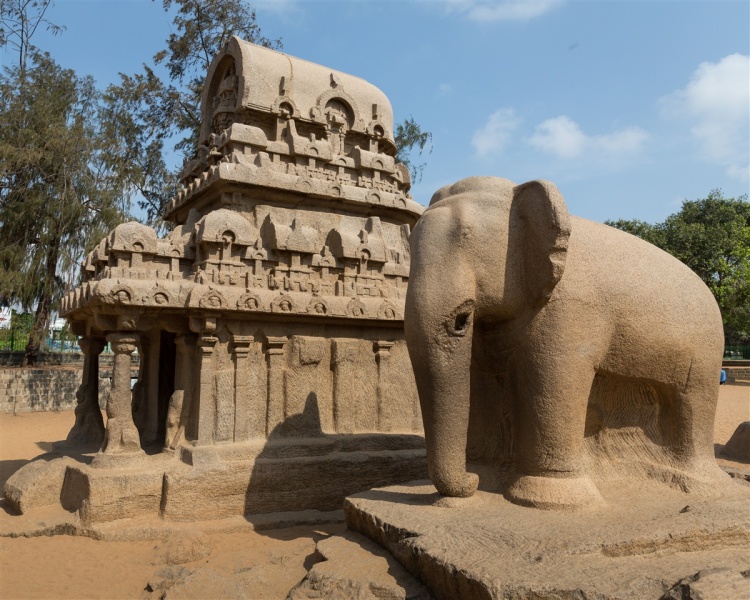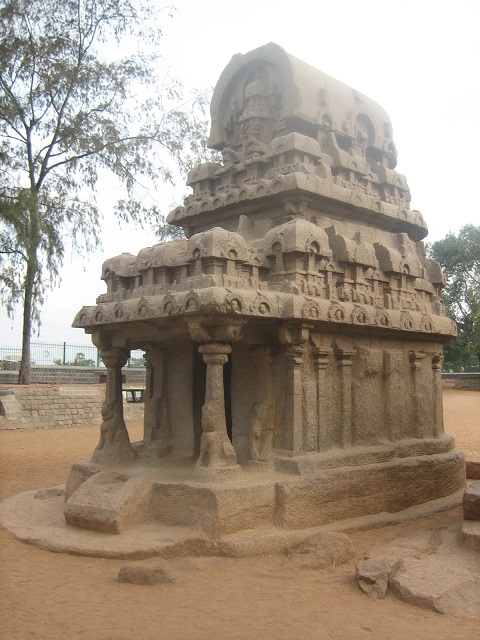Mamallapuram – The Workshop of the Pallavas
Sahadeva Ratha


Sahadeva Ratha is located within the Pancha Ratha complex. Unlike other four rathas, it is hewn out of a separate boulder. The ratha faces north and measures 18 feet in length, 11 feet wide and 16 feet in height1. It is raised above an adhishthana (platform), mouldings of which are not demarcated clearly. A small flight of rock-cut steps is provided to reach the ratha floor. This is a dvi-tala (double story) vimana, the stories are distinguished by a hara decoration of kuta-sala rows.

The ratha has a mukha-mandapa preceding the main cell. This mukha-mandapa is supported on two lion-base pillars. The entrance to the main cell has a doorway in the center however it is devoid of any decoration. Little further from the main entrance, on either side, are two pillars with bases in form of an elephant, a variation from regular lion-base pillars which is not seen elsewhere in Mamallapuram. The excavated cell is devoid of any image.



The style of this ratha will attract any curious visitor. Its style and design is peculiar or strange in terms that very few temples were constructed in this style. It is an apsidal-end temple, as its southern end is in shape of an apse. This kind of style is referred as gajaprishtha in Hindu architectural texts2. This apsidal-end design led Fergusson and others to suggest influence from Buddhist chaitya halls as the latter were designed with an apse or apsidal end to contain a stupa. The exception with the chaitya halls is that these are apsidal from interior as being excavated as caves while this ratha showcases this apsidal end in its exterior. Buddhist influence may not be rejected as evidences for it are strong, however we also have examples of contemporary Hindu temples, being constructed in this architectural style, i.e. Trivikrama tempe at Ter, the Durga temple at Aihole and Kapoteshvara Temple at Chejrala in Andhra Pradesh etc.

An elephant, almost full size, is carved from a separate boulder, and is standing adjacent to this ratha. As the back of this elephant aligns with the apsidal end of the ratha, it appears that this elephant is carved to suggest the similarity between both. Ingenious, isn’t it? The presence of this full size elephant and the elephant figures at the base of the pillars of the cell’s entrance led Longhurst3 to suggest that this ratha was dedicated to Indra, elephant being his mount. The gable end, on the front, showcases a mini temple inside an arch. This temple is an octagonal vimana with an octagonal shikhara. As per the South Indian Agamic texts, Dravida variety of temples have an octagonal shikara. On the top of the arch, there was probably a motif similar to the one seen in Ganesha Ratha. In case, it was a trishula motif, then the temple should be dedicated to Shaivite deity, most probably Shiva itself. Though there was space for niches around the vimana, however no attempt was made to carve imaged inside. A projecting stone at the back of the temple suggest an alcove inside, probably acting as a pedestal or niche for a cult image.
1 Fergusson, J & Burgess, J (1880). The Cave Temples of India. London. pp 135-140
2 Nagaswamy, R (2008). Mahabalipuram. Oxford University Press. New Delhi. ISBN 9780198071273. p 57
3 Longhurst, A H (1928). Pallava Architecture Part II. Archaeological Survey of India. New Delhi. p 21


Main is saal 12th kar RHA hu or aage puratatva bibhag main lagna chahata hu 7417131553 my number
Comments are closed.